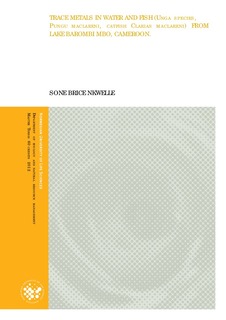| dc.description.abstract | Lake Barombi Mbo is an isolated oligotrophic lake situated in the volcanic range of West Cameroon
and home to several endangered endemic cichlids. A fieldwork was carried out at the lake where
water and fish samples were collected as part of an investigation. The aim of this study was to
investigate (i) whether studied trace metals were present at levels exceeding ambient water criteria,
(ii) link uptake of trace metals in gills and liver of fish to water chemistry, (iii) accumulation of
mercury in muscles and biomagnification along the food chain. ICP-MS and ICP-OES analysis for
concentration of trace metals in water samples from the lake showed that, the total concentrations of
investigated trace metals were below U.S. Environmental Protection Agency (EPA) criteria limits,
Canadian Council of Ministers of the Environment (CCME), South Africa Water Quality Guidelines
and World Health Organization (WHO) guidelines for protecting aquatic life. Linking uptake and
water chemistry, bioconcentration factor (BCF) analyses showed accumulation of trace metals in
both gills and liver of fish. With minor differences in accumulation sequence, all fish species
accumulated Al, Mn, and Sr in highest concentration in their gills with Cu, Cd, Co, Cr, Pb, and U
highest in liver. The highest mean concentration of metal accumulated was observed for Cu (1153
µg/g dw) in liver of U. species. P. maclareni accumulated Al, Cr, Co, Sr, and Pb in highest
concentrations. While U. species had Mn and Cu in highest concentration, Cd was present in highest
concentration in C. maclareni. The high accumulation of Al, Mn and Sr on gills of the three fish
species, indicates that they are bioavailable and probably high levels in Lake Barombi Mbo. Total
mercury concentrations (mg/kg ww) were low with mean values of 0.0093 in U. species, 0.0274 in
P. maclareni and 0.0266 in C. maclareni compared to 0.2 mg/kg WHO recommended guideline for
Total Dietary Intake (TDI) to protect vulnerable groups (pregnant women and children) from
mercury toxicity. Stable isotope analysis of carbon δ
13
C used as index for carbon source and flow,
and nitrogen δ
15
N as index for trophic position within the aquatic food chain were determined. Hg
concentrations in muscle of fish coupled mean δ
13
C (‰) and nitrogen δ
15
N (‰), showed that U.
species had the lowest Hg concentrations, δ
13
C (- 32.9 ‰) and δ
15
N (6.6 ‰), and so occupied the
lowest position of the food chain. C. maclareni and P. maclareni both had the highest Hg levels, but
C. maclareni had the highest δ
15
N (9.9 ‰) and occupied the highest trophic level. Log THg vs. δ
15
N
among all species sampled showed a significant positive relationship indicative of mercury
biomagnification along the food web of Lake Barombi Mbo. Results of trace metal levels in water
and fish tissues suggest that trace metals do not pose a serious threat to the aquatic biota of Lake
Barombi Mbo. | no_NO |
